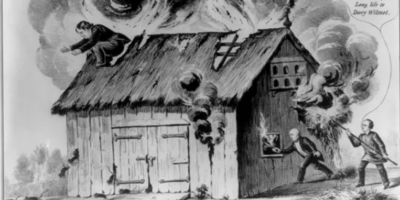By Katie Dixon
Coal and Kentucky. For some the two are tightly bound in deeply rooted tradition and pride. Others see the relationship as a shameful reminder of decades of environmental degradation for the selfish purposes of cheap electricity and swift, easy profits. The “coal issue” is no longer a feud being played out in our distant counties; Lexington’s neighbors to the east may soon share their bluegrass with the Eastern Kentucky Power Cooperative’s (EKPC) newest coal-fired power plant.

New train tracks lead to open land near sight of as-yet unapproved coal plant. Photo by Katie Dixon.
The EKPC’s proposition is to construct a 278-megawatt coal-fueled unit at the J.K. Smith Station in southern Clark County. The Kentucky Division for Air Quality (DAQ) has been working with the EKPC to obtain a Title V air pollution permit that states the emissions from the Smith power plant meet Environmental Protection Agency standards.
The DAQ released a draft of the permit for public comment on January 4, 2010. Typically, the public has 30 days to submit written comments to the DAQ, and a public hearing is held at the end of the 30 days. However, the DAQ submitted incorrect files, so on January 13, the DAQ made the correct files available and in turn extended the written public comment period to February 12. A public hearing was held on Thursday, February 4 at the Clark County Cooperative Extension office in Winchester where supporters of Smith Station and those who oppose the plant gathered to voice their opinions to the DAQ panel and submit their written comments.
At the February 4 meeting, James Morse, a Permit Review Supervisor for the DAQ and mediator of the public hearing, outlined the rules and details to the crowd of almost 200 in a crisp monotone voice. Then he began reading names of those who requested to speak. One of the first people to approach the panel was Megan Naseman of Berea who said, “The EKPC standards were created in 1971 based on results of a study conducted in 1961. Please deny the permit for this plant that will be built based on old standards.”
Immediately after her statement a loud, “We need jobs now!” erupted across the room and was followed by applause and “Amens!”
In a very serious tone Mr. Morse quieted the room and asked Tom Fillman to come forward. Dressed head to toe in denim, Mr. Fillman, a lifelong resident of Winchester, began his statement like casual conversation. “I like hiking and hunting and fishing and being outside. But what that plant is going to do to the air I breathe is going to be something like this.” He then took a thin cigar from the interior pocket of his coat and lit it. As he exhaled smoke out into the room, he said, “Me smoking in here is like what the plant is going to do out there,” and pointed toward window.
Outside, the parking lot was lit by the peachy glow of a street lamp powered by coal-generated electricity.
The DAQ is currently reviewing all public comments and will decide whether or not to proceed with the permit. If they choose to do so, the permit and comments are submitted for a 45 day review period conducted by the EPA. This is the first in a series of permits the EKPC would have to be granted. Water and other permits for the Smith plant still have to be made available for public comment.
Editor’s note: Kentuckians for the Commonwealth is currently mobilizing against the EKPC coal-fired power plant. Visit www.kftc.org if you’d like to join the fight for clean (not coal) energy.




1 Pingback